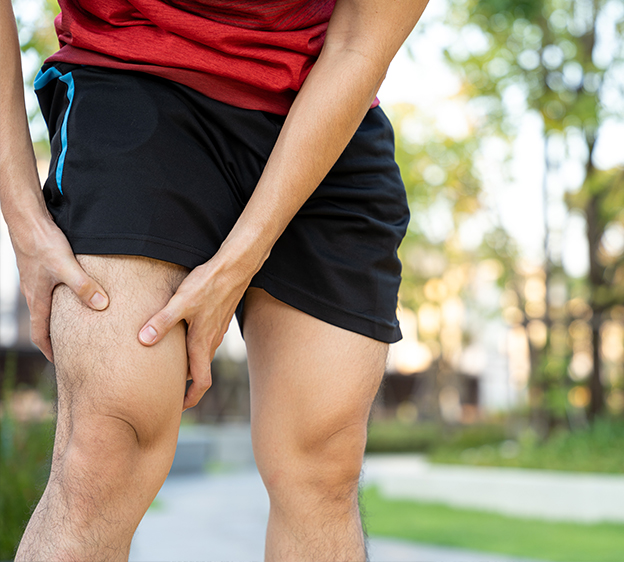
Your hamstring is a group of three muscles: the biceps femoris, semimembranosus and semitendinosus. Together, these muscles stretch along the back of your thigh from the lower pelvis to just below the knee. When healthy, these muscles help bend your knee and extend your leg behind you.
However, when these muscles are injured, even simple activities can become challenging and painful. A hamstring injury can significantly hinder your mobility and quality of life.
“A strained hamstring can bring you to your knees,” says Mary Descaro, PT, DPT, OMT-C, CLT, clinical lead physical therapist at Beaufort Memorial Outpatient Rehabilitation Services. “The sudden pain can knock even elite athletes off their feet and leave you on the sidelines for weeks or months.”
Types of Hamstring Injury
Hamstring injuries can happen to anyone, but they’re most common in people aged 16 to 25. Many of these injuries occur during sports, especially in activities like soccer, sprinting, and football. In fact, studies show that hamstring injuries account for about 10% of athletic injuries in team sports played on a field.
Whatever causes the problem, hamstring strains range in severity. Based on the extent of damage, your injury falls into one of three categories.
- Grade 1. This injury is the least serious. It indicates you’ve experienced a mild hamstring strain in the hamstring that causes minor pain and swelling. Proper care should heal the injury within a few days.
- Grade 2. With this injury, you experience a partial tear in at least one of the three hamstring muscles. You’ll likely have more pain and swelling than with a minor hamstring strain. Recovery time varies.
- Grade 3. The most severe hamstring injury, a grade 3 injury involves a complete tear of the hamstring. Some grade 3 injuries pull the muscle away from the bone. The pain may be instantaneous and severe, and recovery can take months. Orthopedic surgery may be necessary.
Read More: Safety on the Run: Tips to Prevent Running Injuries
Recovering From a Hamstring Injury
Following a hamstring injury, expect pain, swelling and bruising. Your injured leg may be tender to the touch, and you may have a hard time walking.
For minor injuries, RICE is a good first step toward healing.
- Rest. Avoid activities that worsen your pain and limit movement with the affected leg.
- Ice. Two or three times each day, apply ice for twenty minutes to the hurting hamstring.
- Compression. You may experience less swelling and pain by wrapping the injured leg tightly with a compression bandage.
- Elevation. You can reduce swelling by raising your leg while sitting down.
In addition to RICE, ibuprofen, acetaminophen or naproxen can help manage pain. It’s also helpful to use crutches to limit the amount of weight put on the injured area. Additionally, know when to seek medical care from a sports medicine specialist or other expert for treatment of a hamstring injury.
“If your pain is severe, your pain and swelling worsen over time or your recovery takes longer than expected, reach out to your primary care provider,” Descaro says. “You may have a serious injury that needs more aggressive treatment.”
In these cases, physical therapy or orthopedic surgery may help. Diagnostic imaging and other tests can help determine the extent of your injury and what treatment approaches to consider.
Read More: Chronic Pain? It Could Be a Repetitive Stress Injury
Putting Your Hamstring in Harm’s Way
Athletes are more likely to experience a hamstring injury. Runners and dancers are at risk, as are those who play basketball, soccer and football.
However, even the most unathletic people can hurt their hamstrings.
The likelihood of injury increases with the following risk factors:
- Fatigue. When your muscles are worn out, they can’t absorb as much energy in high-impact activities.
- Imbalance. Having stronger muscles in the front of the thigh (quadriceps) than the rear (hamstring) can lead to injury.
- Tightness. Unstretched muscles are at higher risk for damage.
- Unprepared. Weak hamstrings that aren’t in good condition increase the risk of strain.
Exercises Built to Protect Your Hamstrings
Want to build up your resistance to hamstring injury? It’s possible, even if you spend a lot of time on the field or court.
“Being an athlete doesn’t automatically put your hamstring at risk,” Descaro says. “There are plenty of stretching and strengthening exercises that can protect you against hamstring muscle strains.”
Hamstring Stretches
Stretches that improve your range of motion and reduce your risk of a pulled hamstring include:
Seated stretch. Sit on the ground with your right leg straight in front of you. Bend your left leg until your left foot presses against the inside of your right thigh. With your back straight, lean over your right leg for a few seconds. Return to the starting position, repeat two more times, then do the same with the left leg straight and right leg bent.
Towel stretch. Lying on your back, bend your right knee and place your right foot flat on the floor. Let your left leg lie flat, with a towel around the bottom of your left foot. Hold both sides of the towel and lift your left leg straight up over your body. Pull on the towel gently to stretch tight hamstrings. Hold for 15 seconds, return to the starting position and repeat two more times. Then perform the stretch with the opposite leg.
Hamstring Exercises
Exercises that strengthen your hamstring for added protection include:
- Bridges. Lie on your back with your feet planted on the ground. Push your torso and pelvis off the ground, keeping them in a straight line with your thighs. Lift your toes off the ground so your weight is supported by your shoulders and heels. Hold for a few seconds, return to the starting position and repeat.
- Lunges. Start in a standing position. Step forward with one foot and lower your rear knee toward the ground. When the rear knee forms a 90-degree angle, push off your front foot to return to the starting position. Repeat, stepping forward with the opposite foot. Continue stepping forward with one foot after the other.
Is your hamstring is causing you pain? Don’t let it slow you down. Request an appointment with an orthopedic specialist at Beaufort Memorial today.
